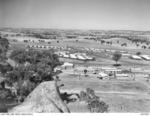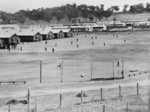The Cowra Breakout
Contributor: Morgan Bell
ww2dbaseFive years after war with Germany and Italy had ignited, and three years after Japan fanned the flames of war in the Pacific, there were 2,223 Japanese prisoners of war held captive in Australia, including 544 merchant seamen; 1,585 Germans; and 720 Italians. The POWs were well fed, given decent medical attention, and encouraged in daily exercise. In winter, extra blankets and warm underwear was issued to the POWs. Under these conditions general health improved, especially amongst the Japanese POWs, many who had been captured in New Guinea, where the Japanese army had been decimated by tropical disease and weakened by starvation. Of the 21,000 Australian POWs captive under the rising sun of Japan's empire during the Second World War, many were malnourished and worked to exhaustion, causing 8,296 deaths in captivity during the Second World War.
ww2dbaseAllied soldiers, captured by the Japanese army during the Second World War faced a daily struggle for survival, but at the No. 12 Prisoner of War compound near Cowra in central-west NSW, Australia, on the tree lined banks of the Lachlan River 227 miles west of Sydney, during 1944, a value system bred into the Japanese men for generations compelled many to charge the wire holding them captive, some got over the fence, all escaped. The way of the warrior, bushido, stated that death in battle was honourable, captivity was not. Taking their lives was the only way to atone for their dishonour according to this ethics rules. Japanese militarists made no attempt at erasing this code from the minds of the country's modern warriors. It was institutionalized in the Japanese Army Field Service Code, which says "He who knows shame is strong and should at all times endeavour to keep before him the honour of his homeland and live up to what it expects of him. Rather than live and bear the shame of imprisonment by the enemy, he should die and avoid leaving a dishonourable name", this was in accordance to the decree issued to all Japanese soldiers by Tojo Hideki in January 1941, called Senjinkun, Lesson for the Battlefield. Adherence to this strict military code, the honour of a captured soldier's family, and Japan itself, was retained by the POW's death. That strict ordinance leaves little room for choice. Australian authorities suspected an incident with the Japanese POWs at the Cowra compound, on 4 August notice had been given that all prisoners below the rank of lance corporal were to be transferred to the Hay Prisoner of War camp. By August there were 1,104 Japanese POWs in the Cowra compound, kept in camp B. At 2am on 5 August 1944 POWs ran towards the gate shouting, a bugle was sounded, then the bulk of the Japanese prisoners rushed at the wire fences, brandishing makeshift weapons to attack any who might oppose them. Australian sentries opened fire, the Japanese prisoners scrambled over the dead bodies of their comrades-at-arms. 400 escaped to open country beyond the fence, 334 were later recaptured. In the slaughter over which they had scrambled to freedom, there was 234 dead and 108 wounded Japanese POWs, and four dead and four wounded Australian guards of the 22nd Australian Garrison Battalion, who were entrusted with the task of guarding the prisoners, two of the Australians killed, Private B. G. Hardy and Private R. Jones, were posthumously honoured with the George Cross, for displaying bravery in their efforts to thwart the escape. No inhabitants of the nearby agricultural centre of Cowra were not disturbed while going about their daily business or harmed by any prisoners that escaped beyond the wire fences, despite Cowra being a city of around three thousand in 1944. On 7 August 1944 a Court of Inquiry, adjudicated by four senior officers of the Australian Army, was convened to investigate the events of 5 August. Central to this investigation were a number of notes written in Japanese script on toilet paper detailing the plot, and signed "Y. S.". On 9 August, four days after the dramatic events, the body of Sergeant Major Yoshio Shimoyama was carried out of camp B, the spark of life strangled from him. The court initially suspected his betrayal of the plot had been found out, and Shimoyama had been lynched, until the court interviewed Matsushima, a Japanese prisoner the notes identified as leader of the riot. Upon cross-examination the court determined that Matsushima had wrote the notes himself, the Y. S. initials were used at random, the man they were taken from died in the break out, by coincidence they corresponded to Shimoyama's initials.
ww2dbaseSources: H. Clarke, Escape to Death, T. Asada, Night of a Thousand Suicides, The Australian War Memorial, J. Beaumont, Australia's War: 1939-45.
Last Major Update: Sep 2008
The Cowra Breakout Interactive Map
Photographs
 |  |
Please consider supporting us on Patreon. Even $1 per month will go a long way! Thank you. Please help us spread the word: Stay updated with WW2DB: |

» Australia
- » 1,177 biographies
- » 337 events
- » 45,081 timeline entries
- » 1,245 ships
- » 350 aircraft models
- » 207 vehicle models
- » 376 weapon models
- » 123 historical documents
- » 261 facilities
- » 470 book reviews
- » 28,492 photos
- » 365 maps
Winston Churchill, on the RAF